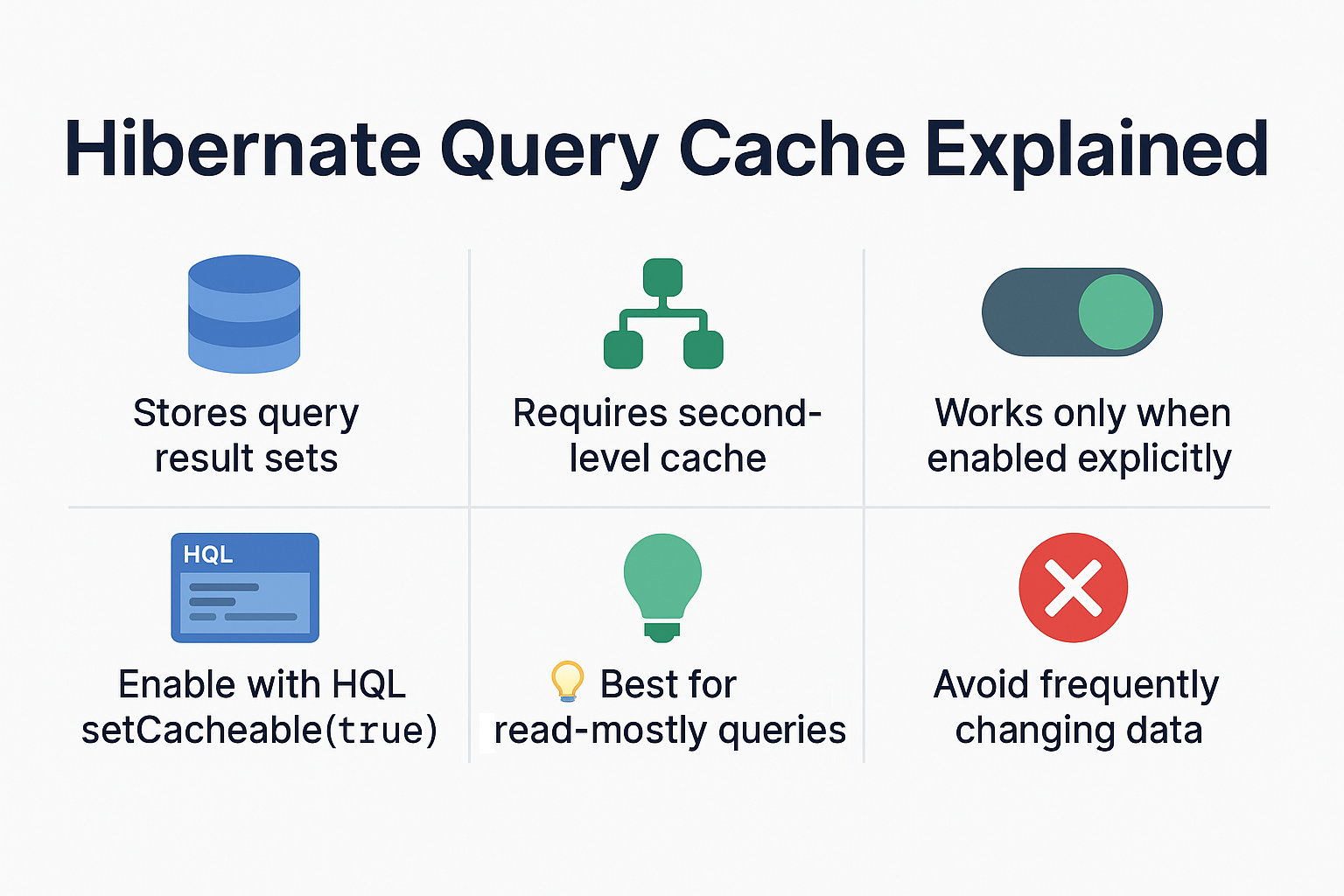In large enterprise applications, frequent database queries can lead to performance bottlenecks. Hibernate, as a popular ORM (Object Relational Mapping) framework, provides caching mechanisms to minimize database access and boost performance. One of the most powerful features is the Hibernate Query Cache, which stores the results of queries, so the same query doesn’t repeatedly hit the database.
Think of it like asking your teacher the same question multiple times. Instead of repeating the full explanation every time, the teacher hands you a written note with the answer. That’s exactly what query caching does—it reuses the answer.
In this tutorial, we’ll cover everything from core concepts to advanced use cases, including Ehcache, Infinispan, and Spring Boot integration.
What is Hibernate Query Cache?
The Hibernate Query Cache is a second-level cache extension that stores query results. Unlike the first-level cache (Session-level) and second-level cache (entity-level), query cache stores the IDs of entities returned by a query. When the same query is executed again, Hibernate uses these cached IDs to fetch results, reducing query execution time.
✅ Key points:
- Stores result sets of queries (not the entities themselves).
- Works in conjunction with the second-level cache.
- Must be explicitly enabled in configuration.
- Useful for read-mostly queries like reference tables (categories, products, etc.).
Setting up Hibernate Query Cache
1. Enable Second-Level Cache
## hibernate.cfg.xml or application.properties
hibernate.cache.use_second_level_cache=true
hibernate.cache.region.factory_class=org.hibernate.cache.ehcache.EhCacheRegionFactory
hibernate.cache.use_query_cache=true
2. Example Entity Mapping
@Entity
@Table(name = "Product")
public class Product {
@Id
@GeneratedValue(strategy = GenerationType.IDENTITY)
private Long id;
private String name;
private double price;
// getters and setters
}
Using Hibernate Query Cache
HQL Example with Query Cache
Session session = sessionFactory.openSession();
Transaction tx = session.beginTransaction();
Query<Product> query = session.createQuery("FROM Product p WHERE p.price > :minPrice", Product.class);
query.setParameter("minPrice", 1000);
query.setCacheable(true); // Enable query cache for this query
List<Product> products = query.list();
tx.commit();
session.close();
✅ On the first run, the query hits the database and caches the result.
✅ On subsequent runs, Hibernate fetches from the query cache if the second-level cache has the entities.
Real-World Example: Query Cache in Spring Boot
@Repository
public class ProductRepository {
@PersistenceContext
private EntityManager entityManager;
public List<Product> findExpensiveProducts(double minPrice) {
Query query = entityManager.createQuery("FROM Product p WHERE p.price > :minPrice");
query.setParameter("minPrice", minPrice);
query.setHint("org.hibernate.cacheable", true);
return query.getResultList();
}
}
Performance Considerations
- Use query cache for static or read-mostly data.
- Avoid caching frequently changing queries (e.g., stock prices).
- Always combine with second-level cache.
- Test before enabling in production—improper use may increase memory load.
⚠️ Anti-patterns:
- Caching queries that return huge result sets.
- Using query cache for frequently updated tables.
- Misconfiguring eviction policies in Ehcache/Infinispan.
Best Practices
- Enable query cache only for queries that benefit from it.
- Set proper eviction policies in the cache provider.
- Monitor cache hit/miss ratios in production.
- Prefer entity-level second-level caching for individual entity lookups.
📌 Hibernate Version Notes
-
Hibernate 5.x
- Uses
org.hibernate.cache.ehcache.EhCacheRegionFactory - Legacy XML-based configurations supported
- Query cache API requires manual hints
- Uses
-
Hibernate 6.x
- Migrated to Jakarta Persistence (
jakarta.persistencepackage) - Enhanced SQL support and query caching strategies
- New APIs for better cache region management
- Migrated to Jakarta Persistence (
FAQs
1. What’s the difference between Hibernate and JPA?
Hibernate is an ORM framework; JPA is a specification. Hibernate is one of JPA’s implementations.
2. How does Hibernate caching improve performance?
It reduces round-trips to the database by reusing cached entities and queries.
3. What are the drawbacks of eager fetching?
Eager fetching can load unnecessary data, leading to performance issues.
4. How do I solve the N+1 select problem in Hibernate?
Use JOIN FETCH, batch fetching, or second-level caching.
5. Can I use Hibernate without Spring?
Yes, Hibernate can run standalone, but Spring Boot simplifies configuration.
6. What’s the best strategy for inheritance mapping?
Depends on use case—SINGLE_TABLE for performance, JOINED for normalization.
7. How does Hibernate handle composite keys?
By using @EmbeddedId or @IdClass annotations.
8. How is Hibernate 6 different from Hibernate 5?
Hibernate 6 adopts Jakarta EE namespaces and introduces query API improvements.
9. Is Hibernate suitable for microservices?
Yes, but lightweight solutions like JOOQ may be better for some use cases.
10. When should I not use Hibernate?
Avoid for high-performance, low-latency apps where direct SQL or JDBC is required.
Conclusion & Key Takeaways
- Hibernate Query Cache stores query result sets, improving performance for repeated queries.
- Must be enabled with the second-level cache.
- Works best for read-mostly scenarios.
- Always test and monitor cache usage in production.
By mastering Hibernate Query Cache, you can significantly improve the scalability and responsiveness of your enterprise applications.
